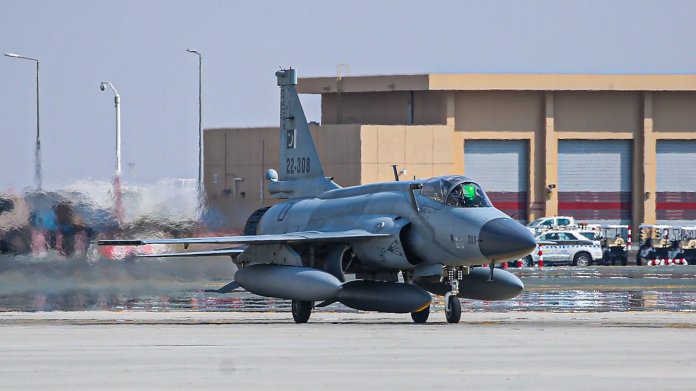TAIPEI - The Pakistan Air Force (PAF) has not seen serious air combat since the 1965 and 1971 wars with India, but the ability to defeat a massive Indian assault on its air defenses early in a war remains its primary mission.
In 1965, Pakistan successfully trumped India in air combat, but it was ill-prepared for the 1971 conflict in which India dominated the skies. Fears of losing another war, much less a nuclear war, are unthinkable, and the PAF is modernizing its air interdiction, air surveillance and reconnaissance, command and control, and honing its air delivery skills for nuclear weapons.
Air interdiction is the PAF's primary mission, but it has not ignored retaliatory strike missions, said Haris Khan of the Pakdef Military Consortium. The PAF has expanded modernization efforts to include "nuclear weapons delivery, support of ground operations, fleet protection/maritime strike, and search and rescue are secondary," he said.
The PAF believes the Indian Air Force will launch a massive assault on Pakistan's air defense and command-and-control hubs during the first wave of a war, said A.B. Mahapatra, director of the New Delhi-based Centre for Asian Strategic Studies - India.
The Indian Air Force's primary mission is to neutralize Pakistan's nuclear option, he said.
"Thus, PAF is enhancing its air combat profile to encounter such future challenges," Mahapatra said.
The PAF's interdiction efforts include new and refurbished Lockheed Martin F-16s, now on order, and JF-17 Thunder fighters, built by Pakistan with Chinese assistance, now being manufactured.
In June 2006, the PAF ordered 18 F-16 C/D Block 52M fighters along with an option to procure another 18. A midlife upgrade will augment its existing fleet of 40 F-16 A/B Block 15s, along with buying 20 more F-16 A/B models via the Excessive Defense Articles program.
The F-16s will not be outfitted with nuclear weapons, but question marks remain for the JF-17. Known as the Chengdu J-10 Vigorous Dragon, the JF-17 will replace about 450 aging Nanchang A-5C Fantans, Dassault Mirage III/Vs and Chengdu F-7P Skybolts in the air-to-air combat and ground-support roles.
"The replacement will not be matched by an exact number, but initial reports indicate between 250 and 300 aircraft will be purchased by PAF," Khan said.
Khan said the Pakistan Aeronautical Complex is conducting flight evaluations of prototype aircraft "fitted with the Chinese-built NRIET KLJ-10 radar" and "Chinese-designed SD-10/PL-12 active-homing medium-range air-to-air missile."
The first 50 JF-17s will be outfitted with Chinese avionics, radar and missiles. But under an agreement with France in February, newer JF-17s will be outfitted with MBDA Mica air-to-air missiles and Thales RC 400 multimission radars.
The Russian-built RD-93 turbofan engine outfitting the JF-17 will have to be replaced due to pressure from India on Russia. Khan said the Chinese-built WS-13 Taishan engine is the most likely replacement.
There are unconfirmed reports, Khan said, that the PAF has ordered four aerial refueling tankers, possibly the Ukrainian-built Il-76.
Tentative UAV Plans
PAF also is improving its surveillance and reconnaissance capabilities.
"Pakistan uses UAVs for surveillance and is keen to augment the reconnaissance capabilities to a new height," with plans to procure up to 60 UAVs by 2010, Mahapatra said.
The Army has ordered the Luna short-range UAV from Germany and the Italian-built Galileo Falco UAV.
"An agreement was also signed in July of 2006 between the PAF and Turkey to jointly manufacture a UAV, which will meet the requirements of both air forces. The PAF UAV program is still in its adolescent stage, but they acknowledge the significance of the program for its future war plans," Khan said.
In April, the first of five Saab 2000 turboprop aircraft equipped with the Saab-Ericsson Erieye Airborne Early Warning & Command (AEW&C) system was rolled out during a ceremony in Sweden. Delivery to Pakistan is expected in mid-2009. Khan said there are discussions with China to co-develop an AEW&C aircraft designated as ZDK03 modeled on the Shaanxi Y-8F-400.
"PAF has mapped a very detailed and comprehensive plan for an early warning system to cover Pakistan's airspace with both airborne platforms and a ground-based radar network," he said.
Pakistan will integrate this plan with ground-based radar, including the U.S.-supplied AN/TPS-77 and Chinese-supplied JYL-1, JL3D-90A and JY-11 D air surveillance radars.
Khan points to other efforts, including a 2006 test of the Czech Vera passive radar system and an order for a number of MBDA Aspide/Spada 2000 low- to medium-altitude air defense batteries.
"These missiles are supposed to replace Thales Defence Systems Crotale. PAF is actively looking to purchase a high-altitude missile air defense system," with the Chinese-built FT-2000 as the front-runner, Khan said.
In the 1965 and 1971 wars with India, Pakistan successfully attacked ground targets, including high-value targets, within 200 miles of Pakistan's border.
Khan said in any future conflict with India, "I believe PAF will employ similar tactics," but with more intensity on high-value targets.
"PAF would, in the first instance, be tasked with countering India's planned advance into Pakistani territory by seeking to prevent the Indian Air Force from achieving local tactical air superiority," he said. "At the same time, it would be required to strike surface-to-surface missile launchers, if these can be identified. It would also be called upon to provide air cover for the strike corps in their limited advance to occupy Indian territory."
:quality(70)/cloudfront-us-east-1.images.arcpublishing.com/archetype/C3KZ2VHMQJH3BABQPT6XUUT2XM.jpg)


:quality(70)/cloudfront-us-east-1.images.arcpublishing.com/archetype/4GCO24O3TZFPJO3WZ5ZTOYH3QA.jpg)



